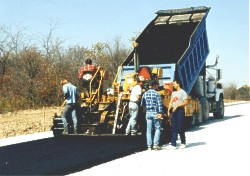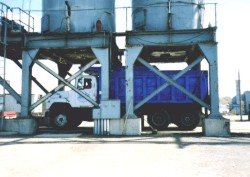By Jerzy Z. Zemajtis, Ph.D., PE (WA)*
The length of adequate curing time is dependent on the following factors:
- Type of cementitious materials used
- Mixture proportions
- Specified strength
- Size and shape of concrete member
- Ambient weather conditions
- Future exposure conditions
American Concrete Institute (ACI) Committee 301 recommends a minimum curing period corresponding to concrete attaining 70% of the specified compressive strength2. The often specified 7-day curing commonly corresponds to approximately 70% of the specified compressive strengths. The 70% strength level can be reached sooner when concrete cures at higher temperatures or when certain cement/admixture combinations are used. Similarly, longer time may be needed for different material combinations and/or lower curing temperatures. For this reason, ACI Committee 308 recommends the following minimum curing periods3:
- ASTM C 150 Type I cement 7 days
- ASTM C 150 Type II cement 10 days
- ASTM C 150 Type III cement 3 days
- ASTM C 150 Type IV or V cement 14 days
- ASTM C 595, C 845, C 1157 cements variable
Figure 1. Moist Curing Time and Compressive Strength Gain
There are three main functions of curing:
1) Maintaining mixing water in concrete during the early hardening process
a. Ponding and immersion
Ponding is typically used to cure flat surfaces on smaller jobs. Care should be taken to maintain curing water temperature at not more than 11°C (20°F) cooler than the concrete to prevent cracking due to thermal stresses.
Immersion is mainly used in the laboratory for curing concrete test specimens.
b. Spraying and fogging
Spraying and fogging are used when the ambient temperatures are well above freezing and the humidity is low. Fogging can minimize plastic shrinkage cracking until the concrete attains final set.
c . Saturated wet coverings
Wet coverings saturated with water should be used after concrete has hardened enough to prevent surface damage. They should be kept constantly wet.
d. Left in Place Forms
Left in place forms usually provide satisfactory protection against moisture loss for formed concrete surfaces. The forms are usually left in place as long as the construction schedule allows. If the forms are made of wood, they should be kept moist, especially during hot, dry weather.
2) Reducing the loss of mixing water from the surface of the concrete
a. Covering concrete with impervious paper or plastic sheets3) Accelerating strength gain using heat and additional moisture
Impervious paper and plastic sheets can be applied on thoroughly wetted concrete. The concrete surface should be hard enough to prevent surface damage from placement activities.
b. Applying membrane-forming curing compounds
Membrane-forming curing compounds are used to retard or reduce evaporation of moisture from concrete. They can be clear or translucent and white pigmented. White-pigmented compounds are recommended for hot and sunny weather conditions to reflect solar radiation. Curing compounds should be applied immediately after final finishing. Curing compound shall comply with ASTM C3094 or ASTM C13155.
a. Live steam
Live steam at atmospheric pressure and high-pressure steam in autoclaves are the two methods of steam curing. Steam temperature for live steam at atmospheric pressure should be kept at about 60°C (140°F) or less until the desired concrete strength is achieved.
b. Heating coils
Heating coils are usually used as embedded elements near the surface of concrete elements. Their purpose is to protect concrete from freezing during cold weather concreting.
c. Electrical heated forms or pads
Electrical heated forms or pads are primarily used by the precast concrete producers.
d. Concrete blankets
Concrete insulation blankets are used to cover and insulate concrete surfaces subjected to freezing temperatures during the curing period. The concrete should be hard enough to prevent surface damage when covering with concrete blankets.
Other forms of curing include internal moist curing with lightweight aggregates or absorbent polymer particles. For mass concrete elements (usually thicker than 3 ft.), a thermal control plan is usually developed to help control thermal stresses. Additional information can be found in ACI Committee 308 report Guide to Curing Concrete3. For specialty concretes, it is recommended to refer to other ACI reports as follows:
- Refractory concrete ACI 547.1R
- Insulating concrete ACI 523.1R
- Expansive cement concrete ACI 223
- Roller-compacted concrete ACI 207.5R
- Architectural concrete ACI 303R
- Shotcrete ACI 506.2
- Fiber-reinforced concrete ACI 544.3R
- Vertical slipform construction ACI 313
Curing in either cold or hot weather requires additional attention. In cold weather, some of the procedures include heated enclosures, evaporation reducers, curing compounds, and insulating blankets. The temperature of fresh concrete shall be above 10°C (50°F). The curing period for cold weather concrete is longer than the standard period due to reduced rate of strength gain. Compressive strength of concrete cured and maintained at 10°C (50°F) is expected to gain strength half as quickly as concrete cured at 23°C (73°F). In hot weather, curing and protection are critical due to rapid moisture loss from fresh concrete. The curing actually starts before concrete is placed by wetting substrate surfaces with water. Sunscreens, windscreens, fogging, and evaporation retardants can be used for hot weather concrete placements. Since concrete strength gain in hot weather is faster, curing period may be reduced. Additional information can be found in ACI 306.1, Standard Specification for Cold Weather Concreting, ACI 306R, Cold Weather Concreting, ACI 305.1, Specification for Hot Weather Concreting, and ACI 305R, Hot Weather Concreting.
Curing Concrete Test Specimens
Curing of concrete test specimens is usually different from concrete placed during construction. American Society for Testing and Materials (ASTM) has developed two standards for making and curing concrete specimens. ASTM C192 6 is intended for laboratory samples while ASTM C317 is intended for field samples. Both documents provide standardized requirements for making, curing, protecting, and transporting concrete test specimens under field or laboratory conditions, respectively.
ASTM C192 provides procedures for evaluation of different mixtures in laboratory conditions. It is usually used in the initial stage of the project, or for research purposes.
ASTM C31 is used for acceptance testing and can also be used as a decision tool for form or shoring removal. Depending on its intended purpose, the standard defines two curing regimes: standard curing for acceptance testing and field curing for form/shoring removal. Variation in standard curing of test specimens can dramatically affect measured concrete properties. According to the National Ready Mix Concrete Association 8 (NRMCA), strength for concrete air cured for one day followed by 27 days moist cured will be approximately 8% lower than for concrete moist cured for the entire period. The strength reduction is 11% and 18% for concrete specimens initially cured in air for 3 days and 7 days, respectively. For the same air/moist curing combinations, but 38°C (100°F) air curing temperature, the 28-day strength will be approximately 11%, 22%, and 26% lower, respectively.
* Jerzy Z. Zemajtis, Ph.D., PE (WA)
Senior Engineer, CTLGroup, Skokie, IL
begin_of_the_skype_highlighting (847) 832-0260 end_of_the_skype_highlighting, jzemajtis@ctlgroup.com
(847) 832-0260 References:
1S. Kosmatka et al, Design and Control of Concrete Mixtures, 14th Edition, PCA Engineering Bulletin EB 001, Portland Cement Association , Skokie, IL 2002
2 Specifications for Structural Concrete, ACI 301 (www.concrete.org)
3 Guide to Curing Concrete, ACI 308R-01 (www.concrete.org)
4 ASTM C309, Standard Specification for Liquid Membrane-Forming Compounds for Curing Concrete (www.astm.org)
5 ASTM C1315, Standard Specification for Liquid Membrane-Forming Compounds Having Special Properties for Curing and Sealing Concrete (www.astm.org)
6 ASTM C192 / C192M, Standard Practice for Making and Curing Concrete Test Specimens in the Laboratory (www.astm.org)
7 ASTM C31 / C31M, Standard Practice for Making and Curing Concrete Test Specimens in the Fieldwww.astm.org) (
8 David N. Richardson, Review of Variables that Influence Measured Concrete Compressive Strength, NRMCA Publication 179, NRMCA, Silver Spring, MD, 1991.
The Link Between Concrete Sustainability and Curing
Sustainability, according to the Bruntland Report and adopted by many experts, is development that meets the needs of the present without compromising the ability of future generations to meet their own needs. This can be accomplished in one of two ways: either by using recyclable, reusable, or so little resources that future generations have the same access to them; or by producing development that meets our needs as well as the needs of future generations. We can use proper curing of concrete to advance towards the reduction of resource use.
A concrete element is expected to last a certain number of years. In order to meet this expected service life, it must be able to withstand structural loading, fatigue, weathering, abrasion, and chemical attack. The duration and type of curing plays a big role in determining the required materials necessary to achieve the high level of quality.
When smart, suitable, and practical curing is used, the amount of cement required to achieve a given strength and durability can be reduced by either omission or replacement with supplementary cementitious materials. Since the cement is the most expensive and energy intensive portion of a concrete mixture, this leads to a reduction in the cost as well as the absolute carbon footprint of the concrete mixture. Additionally, being practical with curing methods can enhance sustainability by reducing the need for resource intensive conditioning treatments, should the curing method be incompatible with the intended service environment.
Curing Pavements and Bridge Decks
While curing of concrete is an important issue with all concrete applications concrete pavements and bridge decks require careful consideration and have significantly different needs with regard to curing of the concrete of these structures. Both categories have basic requirements for the durability of the structures including strength, abrasion resistance, freezing and thawing and deicer resistance, and, in the case of bridges, low permeability for corrosion protection of the reinforcement of the structure.
Curing compounds should be applied to pavements as soon as possible after bleed water has left the surface of the concrete at a rate of 5 m 2/L (200 ft2/gal) for standard mixtures and application, 3.75 m2/L (150 ft2/gal) for fast track paving, and 2 1/2 m2/L (100 ft2/gal) for slabs thinner than 125 mm (5.0 in.)
In contrast concrete bridges require a higher standard of curing to achieve the low permeability required for protection of steel reinforcement. Standard recommendations for curing bridge decks is moist curing for a minimum of 7 days for concrete mixtures containing only portland cement and as long as 14 days when supplementary cementing materials are included in the concrete mixture. Some states also require the application of curing compound upon removal of the moist curing methods.
Typical moist curing for bridge decks requires the application of adequate quality water saturated burlap or other approved absorptive material covered with minimum 6 mil plastic covering. The temperature of the saturated materials should be within 11°C (20°F) of the temperature of the in-place concrete. In most cases plastic will be specified to be white in color to reflect solar radiation, reducing the temperature rise beneath the plastic, while cold temperatures (less than 10°C (50°F)) may allow the use of black plastic to add heat to the system. Proper moist curing will also require uncovering and rewetting the absorptive material to assure that there is a constant supply of water available to satisfy the evaporation rate at the project site.
References
Design and Control of Concrete Mixtures, 14th Edition, EB001
Construction Specification Guidelines for Concrete Streets and Local Roads, IS119
HPC Bridge Views, Issue No. 45, Fall 2006





